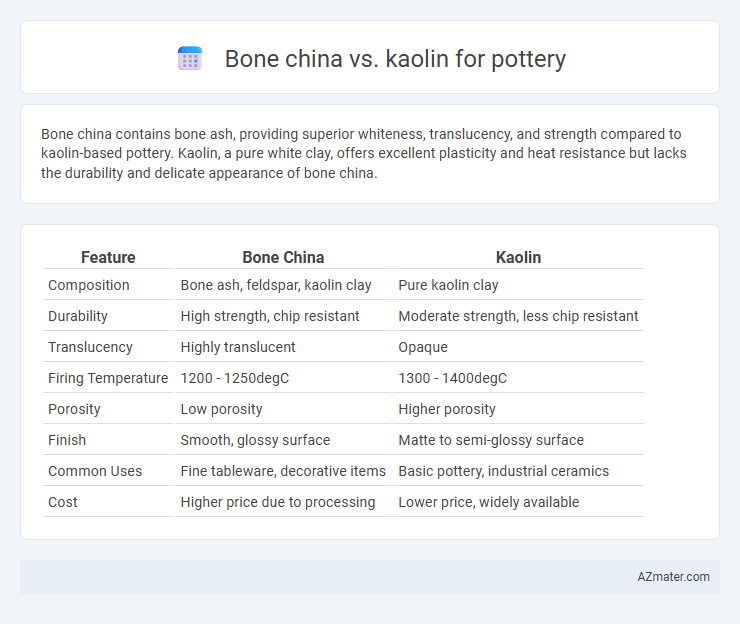Bone china contains bone ash, providing superior whiteness, translucency, and strength compared to kaolin-based pottery. Kaolin, a pure white clay, offers excellent plasticity and heat resistance but lacks the durability and delicate appearance of bone china.
Table of Comparison
| Feature | Bone China | Kaolin |
|---|---|---|
| Composition | Bone ash, feldspar, kaolin clay | Pure kaolin clay |
| Durability | High strength, chip resistant | Moderate strength, less chip resistant |
| Translucency | Highly translucent | Opaque |
| Firing Temperature | 1200 - 1250degC | 1300 - 1400degC |
| Porosity | Low porosity | Higher porosity |
| Finish | Smooth, glossy surface | Matte to semi-glossy surface |
| Common Uses | Fine tableware, decorative items | Basic pottery, industrial ceramics |
| Cost | Higher price due to processing | Lower price, widely available |
Introduction: Bone China vs Kaolin in Pottery
Bone china and kaolin both play crucial roles in pottery, with bone china known for its high strength, translucency, and fine texture due to the inclusion of bone ash. Kaolin, a pure white clay mineral, serves as the primary ingredient in porcelain production, offering durability and resistance to high temperatures. The key difference lies in bone china's unique composition that enhances whiteness and translucency, while kaolin provides structural integrity and plasticity essential for shaping ceramic wares.
What is Bone China?
Bone china is a type of porcelain that uniquely incorporates bone ash, typically derived from animal bones, into its composition, resulting in exceptional translucency and high mechanical strength. Its blend of kaolin, bone ash, and feldspar provides a distinct lightweight yet durable quality, making it highly valued for fine tableware and decorative pottery. Unlike standard kaolin pottery, bone china offers enhanced whiteness and a delicate, smooth finish that resists chipping and maintains brilliance over time.
Understanding Kaolin Clay
Kaolin clay, a primary ingredient in both bone china and traditional pottery, is prized for its fine particle size and high purity, which yield a smooth, white finish and excellent plasticity. In bone china production, kaolin combines with bone ash and feldspar to enhance translucency and strength, whereas in pottery, it improves workability and firing durability. Understanding kaolin's mineral composition and thermal behavior is essential for artisans to optimize the aesthetic and functional properties of their ceramic creations.
Composition Differences
Bone china contains a significant proportion of bone ash, typically around 30-45%, combined with kaolin and feldspar, which gives it a unique translucency and high strength. Kaolin, a primary white clay mineral, serves as the main component in traditional porcelain and pottery, offering excellent plasticity and whiteness but lacks the durability and translucency provided by bone ash. The distinct composition differences result in bone china ceramics being more refined and resilient compared to kaolin-based pottery, which has a more opaque and less durable finish.
Manufacturing Processes
Bone china manufacturing involves blending bone ash, feldspathic material, and kaolin, followed by high-temperature firing at approximately 1200degC to achieve translucency and strength. Kaolin pottery, primarily using pure kaolin clay, undergoes lower firing temperatures around 1000-1300degC, depending on the specific ceramic type, emphasizing plasticity and shape retention. The inclusion of bone ash in bone china alters the microstructure, enhancing whiteness and mechanical durability compared to kaolin-based pottery.
Strength and Durability Comparison
Bone china, composed of bone ash, feldspar, and kaolin, offers superior strength and durability compared to traditional kaolin pottery due to its high calcium phosphate content, which enhances its mechanical resilience. Kaolin pottery, primarily made from white clay, tends to be more porous and less resistant to chipping under stress, resulting in lower overall durability than bone china. The vitrification process during bone china firing produces a denser, more translucent material, which contributes to its exceptional strength and long-lasting quality in fine ceramics.
Aesthetic Qualities: Translucency and Color
Bone china offers superior translucency and a delicate, warm white color due to its high bone ash content, making it ideal for fine, elegant pottery. Kaolin, while providing a pure white and smooth surface, lacks the translucency of bone china but excels in durability and opacity. The choice between bone china and kaolin significantly influences the aesthetic appeal of pottery, with translucency and color being critical factors.
Pottery Applications and Uses
Bone china and kaolin serve distinct roles in pottery applications, with bone china prized for its translucency, strength, and fine texture, making it ideal for high-quality tableware and decorative items. Kaolin, a primary clay mineral, provides plasticity and durability, essential for shaping pottery and producing porcelain and stoneware with excellent whiteness and smooth surfaces. While bone china incorporates bone ash for enhanced whiteness and toughness, kaolin remains a fundamental raw material influencing the structural integrity and firing behavior of ceramic products.
Cost and Availability
Bone china, composed of bone ash, feldspathic material, and kaolin, typically incurs higher production costs due to the intricate firing process and quality of raw materials, making it more expensive than kaolin-based pottery. Kaolin, a primary clay mineral abundant and widely available, offers a cost-effective alternative, often used in stoneware and porcelain production with greater accessibility in raw material markets. The availability of kaolin deposits globally ensures more consistent supply and lower costs, while bone china's reliance on bone ash limits material sourcing, influencing overall pricing and availability for pottery manufacturers.
Choosing Between Bone China and Kaolin
Choosing between bone china and kaolin for pottery depends on the desired characteristics and application. Bone china is prized for its high strength, translucency, and smooth, white appearance due to its unique composition including bone ash, making it ideal for fine dinnerware and decorative pieces. Kaolin, a primary clay mineral, offers plasticity and durability, essential for traditional ceramics and porcelain, favored in pottery that requires high firing temperatures and robustness.

Infographic: Bone china vs Kaolin for Pottery
 azmater.com
azmater.com